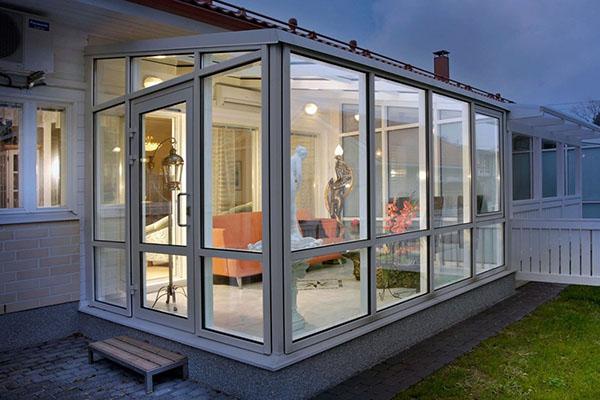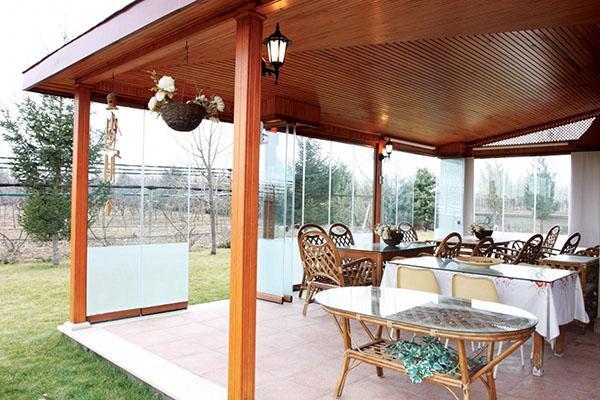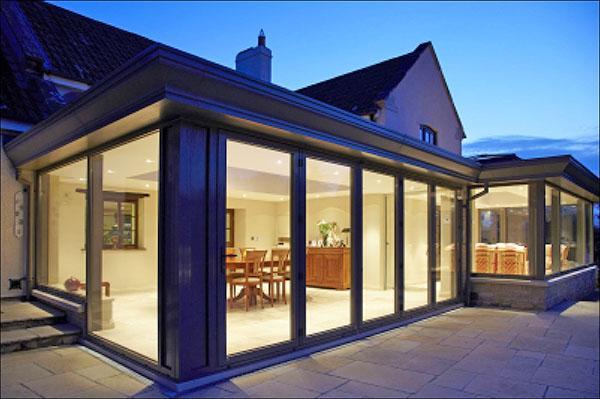The choice of the type of glazing for the terrace and veranda of a country house or summer cottage
 Country houses and summer cottages are often complemented by terraces and verandas in the local area. The glazing of the veranda improves comfort, protects against the vicissitudes of the weather and gives a sense of unity with the surrounding nature.
Country houses and summer cottages are often complemented by terraces and verandas in the local area. The glazing of the veranda improves comfort, protects against the vicissitudes of the weather and gives a sense of unity with the surrounding nature.
Verandas and terraces perform a similar function, but have some structural differences. Terrace is a platform with an independent foundation. It can be either completely open or glazed. Veranda is always adjacent to the house and has a common foundation.
Glazing types
Depending on what functions the site glazing should perform, its type is selected.
Cold and warm

One option is to use single glazing and wooden frames. Aluminum sliding structures have a longer service life and high performance characteristics.
 Warm glazing has great functions. It creates not only a fence, but also has heat-saving properties, allowing you to create a comfortable microclimate. To make the room residential, windows for the veranda to the country house are selected with high reliability and good thermal insulation properties.
Warm glazing has great functions. It creates not only a fence, but also has heat-saving properties, allowing you to create a comfortable microclimate. To make the room residential, windows for the veranda to the country house are selected with high reliability and good thermal insulation properties.
Such a system should be installed by specialists in compliance with all the necessary requirements. In terms of their performance and installation requirements, these are more complex designs that require a professional approach to installation.
You can spend time on the glassed-in veranda in any weather.
Partial and solid
Depending on what requirements are imposed, the glazing of the veranda and terrace is made complete or partial. Full allows you to create a full-fledged enclosed space, with cold or warm glazing. Partial is a simpler option in which the functional requirements are much lower.
For heating the veranda, you can use not only standard systems, but also organize a warm floor.
Frameless glazing
 The full impression of open space is given by the frameless glazing of the veranda. This approach to the design of verandas begins its history in the seventies. This type of glazing looks light and modern. It is based on high-strength transparent glass surfaces up to 1 cm thick.
The full impression of open space is given by the frameless glazing of the veranda. This approach to the design of verandas begins its history in the seventies. This type of glazing looks light and modern. It is based on high-strength transparent glass surfaces up to 1 cm thick.
The glass veranda is created on the principle of closely spaced surfaces with seals at the joints. This allows you to achieve the required tightness and prevents rain and dust from entering. Fasteners are made using aluminum elements at the top and bottom of the opening.
Despite the external lightness and fragility, this type of glazing is durable. The frameless glazing of the veranda and terrace is protected from accidental opening. Equipped with special locks, such windows and doors are protected from burglary. The special glass used in production is safe because it is practically impossible to break it.
Among the advantages of using tempered glass:
- good natural light;
- protection against flying fragments when breaking - they linger on the film;
- hygiene;
- saving free space;
- not susceptible to corrosion.
Of the disadvantages of this glazing method, it should be noted low noise and thermal insulation. Care for such surfaces needs special - you cannot use aggressive cleaning agents, newspaper, as well as hard washcloths.
Frameless glazing is popular not only in the arrangement of verandas, but also in offices and shopping and entertainment complexes.
Sliding system
 Sliding windows for the veranda are especially relevant in the summer. If necessary, such glazing can be moved, freeing up additional space. By their principle of operation, such systems are similar to the organization of sliding wardrobes with guides.
Sliding windows for the veranda are especially relevant in the summer. If necessary, such glazing can be moved, freeing up additional space. By their principle of operation, such systems are similar to the organization of sliding wardrobes with guides.
The disadvantages of the sliding design include the lack of tightness. In this regard, sliding systems are in demand only with cold glazing.
Advantages of sliding windows:
- the glazed veranda is easy to clean;
- sufficient protection against wind, dust, rain is provided;
- operational safety - absence of spontaneous plowing.
Glass can be used not only transparent, but also frosted, stained glass or with a relief. Additionally, tinting, photo printing or drawing can be applied to it.
The sliding systems themselves can be made of the following materials:
- aluminum;
- wood;
- PVC;
- polycarbonate glass.
Sliding systems go well with horizontal blinds and roller blinds.
Portals
 For small-sized verandas, a sliding portal system can be organized. These are heavy in weight and solid structural elements made of wood, PVC or aluminum. Usually they are controlled from the remote control.
For small-sized verandas, a sliding portal system can be organized. These are heavy in weight and solid structural elements made of wood, PVC or aluminum. Usually they are controlled from the remote control.
For glazing the veranda, combined-type portals can be mounted:
- sliding folding;
- lifting and sliding;
- parallel-sliding;
- sliding folding.
Types of materials
When choosing windows for the veranda, it is necessary to provide for good air circulation, sunlight, and the presence of mosquito nets.
Aluminum structures
 The aluminum profile is lightweight and relatively inexpensive. The advantages of using this material include resistance to rust and corrosion processes. The profile color can be customized according to design requirements and personal preference.
The aluminum profile is lightweight and relatively inexpensive. The advantages of using this material include resistance to rust and corrosion processes. The profile color can be customized according to design requirements and personal preference.
Systems based on aluminum profiles can be of two types:
- sliding;
- swing.
The stylishness and modernity of the design, and the ability to create complex structures, make it possible to make glazed verandas and terraces to the house, as in the photo, not only functional, but also attractive. In addition, the possibility of implementing panoramic glazing is created.
The work uses a narrow profile. It does not exert significant pressure on the foundation, has good light transmission and is harmoniously combined with any type of finish.
Environmental safety and non-combustibility allows using this material in the immediate vicinity of housing.
Soft windows
 On the basis of durable and high-quality PVC film, soft windows for the veranda are made. This option is suitable if you need to leave free space and open window openings. For this, the film is rolled up and fixed at the top. To cover the veranda from wind and rain, the canvas is rolled out.
On the basis of durable and high-quality PVC film, soft windows for the veranda are made. This option is suitable if you need to leave free space and open window openings. For this, the film is rolled up and fixed at the top. To cover the veranda from wind and rain, the canvas is rolled out.
The construction with the use of PVC film is quite airtight, which allows you to use the veranda even in winter, if you install a heater.
According to its characteristics, the film has high wear resistance, soft windows can be used for at least ten years at any air temperature and difficult weather conditions. Despite this, the material requires careful treatment:
- it is not advisable to fold the canvas at temperatures below 15 degrees of frost;
- must be protected from accidental cuts.
The peculiarity of the production of PVC films imposes a limitation on the size of the panel. If a width of more than 140 cm is needed, then the two canvases are connected together by fusion. This creates a visible seam with a width of 30 mm. For fastening, the film is left about 50 mm around the perimeter. If a doorway is made out in this way, then a lightning is inserted in the middle.
Types of fasteners:
- silicone straps and brackets;
- swivel brackets (they are used with a wide, up to 5 meters, canvas);
- brass or other metal clasps (for widths up to 2 meters).
Depending on whether the structure is supposed to be removable, fasteners can be installed:
- along the perimeter of the canvas;
- only on three sides (sides and bottom), and on top of the PVC film is mounted on the eyelets;
- in cases where the code on the lower edge is not provided for fasteners, it is supplied with a weighting agent.
PVC material is not demanding on maintenance, cleaning can be done with soapy solutions.
Polycarbonate glazing
 The strength and aesthetics of polymer plastic is used in glazing systems for terraces and verandas. It is a durable material that has good light transmission and is a good barrier to rain and wind.
The strength and aesthetics of polymer plastic is used in glazing systems for terraces and verandas. It is a durable material that has good light transmission and is a good barrier to rain and wind.
Flexible windows for verandas can differ in color, thickness, transparency. There are two main types of material: honeycomb and monolithic.
The positive properties of the material include the following:
• environmental friendliness;
• fire safety;
• impact resistance;
• resistance to gusts of wind;
• protection against ultraviolet radiation;
• plasticity, allowing to make structures with bending
• the choice of shades is possible;
• good tolerance of temperature changes;
• ease.
PVC profiles
 The choice in favor of this type is made in cases where the veranda to the house with plastic windows must be warm, with the possibility of using it in winter. There is an additional option for selecting the profile color.
The choice in favor of this type is made in cases where the veranda to the house with plastic windows must be warm, with the possibility of using it in winter. There is an additional option for selecting the profile color.
Such a system is made according to individual measurements.
Recommendations
 When choosing glazing, it is necessary to take into account such important points:
When choosing glazing, it is necessary to take into account such important points:
- Strives to provide sufficient natural light in the room.
- A ventilation system must be provided.
- Glazing must be selected taking into account carefully measured measurements.
- It is advisable to place the terraces on the north or east side of the house.
- The view from the terrace or veranda should be pleasing to the eye.
Before making the final decision on the design of the veranda and the type of its glazing, you should analyze all possible options and choose the most suitable one.